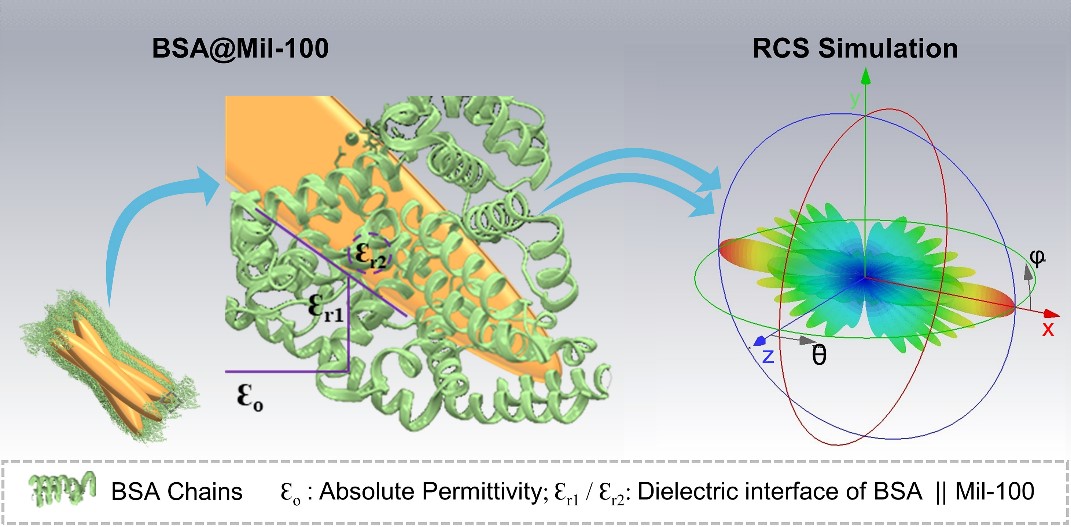| Oct 10, 2023 |
Bio-inspired metal-organic framework achieves efficient absorption of electromagnetic waves
(Nanowerk News) In an effort to develop more effective shielding from electromagnetic (EM) radiation, researchers have turned to nature for inspiration. A new study details how proteins can enhance the properties of metal-organic frameworks (MOFs) to absorb microwave radiation. Published in the journal Small ("Hierarchical-Bioinspired MOFs Enhanced Electromagnetic Wave Absorption"), the findings demonstrate the promise of bioinspired materials to advance EM shielding technologies.
|
Key Takeaways
|
|
Researchers have discovered that proteins, specifically bovine serum albumin (BSA), can improve the microwave absorption capabilities of metal-organic frameworks (MOFs).
The optimized composite, 2-BSA@Mil-100, achieved significant reflection loss at crucial frequencies for radar and satellite communications.
The integration of proteins with MOFs could offer lightweight and flexible shielding against a broad range of microwave frequencies.
Potential applications extend to biomedical devices, defense products, and more.
Despite promising results, further research is needed to assess stability, recyclability, and safety before widespread commercial use.
|
 |
| The results uncover intricate structural parameters, particularly protein cage thickness, and their impact on electromagnetic properties. The present exploration dissects their role in shaping dielectric properties and achieving optimal impedance matching, shedding light on structural mechanisms that contribute to the material's radar cross section (RCS) absorption performance. (Image: Sajid)
|
The Research
|
|
Exposure to EM radiation from sources like radar, cell phones, and wifi has dramatically increased. At the same time, the need for lightweight and flexible radiation shielding continues to grow, especially for electronics and defense applications. Materials like carbon and MOFs have shown potential, but achieving broad, high-performance microwave absorption remains challenging.
|
|
According to the researchers from the High Magnetic Field Laboratory in China, proteins offer a solution to enhance MOFs. The complex molecular structure and functional groups of proteins can guide the formation of intricate MOF networks. Lead author Dr. Kun Ma explained, “Proteins exhibit complex and diverse multi-dimensional structures along with a wide range of functional groups capable of binding metal ions.” By leveraging these traits, the synthesis and resulting morphology of MOFs can be refined.
|
|
To test their hypothesis, the scientists focused on a protein called bovine serum albumin (BSA). Abundant in cows’ blood, BSA contains a suite of amino acids and groups ripe for coordinating with metals. The team combined BSA with an iron-based MOF called Mil-100 in different ratios using hydrothermal synthesis.
|
|
Analyses revealed that a BSA concentration of 40% optimally shaped the MOF into uniform, highly interconnected nanoflowers. This 2-BSA@Mil-100 composite displayed exceptional microwave absorption capabilities. At a mere 2.8 mm thickness, it achieved a reflection loss of -58 dB at 8.85 GHz frequency. This span encompasses the entire Ku band (12-18 GHz) crucial for radar and satellite communications.
|
|
Dr. Ma attributes the enhanced performance to synergistic effects between the BSA and MOF. The amino acid groups likely interact with iron atoms to efficiently convert EM energy into heat. BSA also introduces extra nitrogen-based defects that boost conductivity. Importantly, the biotemplating preserves the high surface area critical for absorption while regularizing the structure.
|
|
Co-author Dr. Junfeng Wang added, “Our research sheds new light on the significance of proteins, specifically biomineralized BSA, in directing the synthesis of MOFs with enhanced structure and microwave absorption performance.”
|
|
Compared to other recent EM shielding materials, the BSA-MOF composite displays exceptional bandwidth in a remarkably thin configuration. With further development, the bioinspired approach could enable lightweight, flexible shielding against a wide spectrum of microwave frequencies.
|
|
Beyond electronics and telecommunications, the materials show promise for biomedical and defense products. Implanted medical devices need protection from EM interference, while radar-absorbing military aircraft and coatings rely on broad bandwidth materials. The study’s lead authors, Dr. Sajid and Xu, noted the BSA@Mil-100’s high absorption capacity makes it well suited for these real-world applications.
|
|
However, the stability and recyclability of proteins integrated with MOFs require further analysis before commercialization. Safety is another key consideration when incorporating biological components into functional materials.
|
|
Nonetheless, experts see the early results as an exciting proof of concept. Harnessing the ancient ingenuity of proteins could be the missing link to enhance next-gen tools reliant on EM shielding. Dr. Wang summarized, “This approach offers a promising new avenue for the design and development of high-performance microwave absorption materials.”
|
|
The synergistic combination of biology and advanced materials may hold solutions to fill critical gaps in emerging technologies. As the researchers now focus on optimization and scaling, their bio-inspired MOFs move closer to enabling lighter, more versatile EM shielding across diverse applications.
|
|
|

